Solas: So. You’ve found me at last. I suspect you have questions.
Spoiler Warning for ALL Dragon Age Games and DLCs!
It finally happened. After over four years since the release of its acclaimed video game title Dragon Age: Inquisition (the third in the trilogy), the December 6, 2018 telecast of The Game Awards featured the moment Dragon Age fans have all been waiting for. BioWare, at long last, teased us with a mysterious new Dragon Age 4 trailer, hashtagged #TheDreadWolfRises.
As you may know from reading my previous analyses on Dragon Age: Inquisition, Solas is one of my favorite characters. Thanks to writer Patrick Weekes, he’s both hot and cold, poetic and brutal, honorable and devious, heroic and villainous. For me, he’s one of the great fantasy characters of all time.
And now we have this dark, delicious, and exciting new trailer that confirms Dragon Age 4, while also clearly pointing to Solas as the focus of at least some of the next game. There’s a lot of good stuff to investigate and analyze, even in a one-minute trailer, so I’ll just jump right in.
The Mysteriously Cropped Mural
First off, I was knocked out to realize that the officially shared mural is actually CROPPED. Sneaky BioWare! There are actually three different versions out there: the original (and most-cropped) version we see with the official BioWare post by Mark Darrah, the slightly wider shot posted by artist Nick Thornborrow (whom both Patrick Weekes and John Epler noted as the fresco artist on social media), and the full, uncropped version that we can only see in the video thumbnail, or as provided to the media.
Here’s what was originally shared:
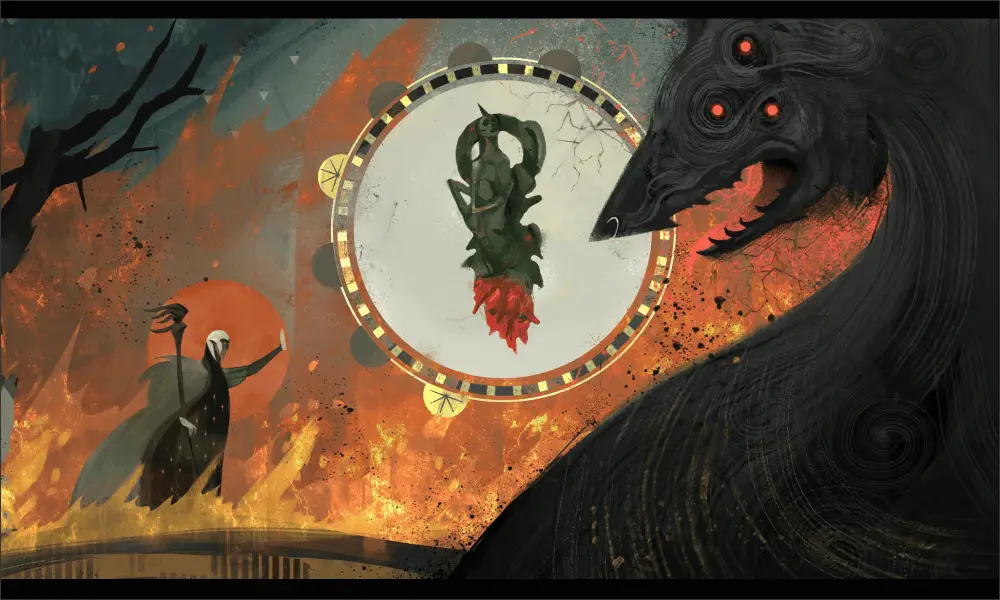
And here’s the full (harder-to-find) version:
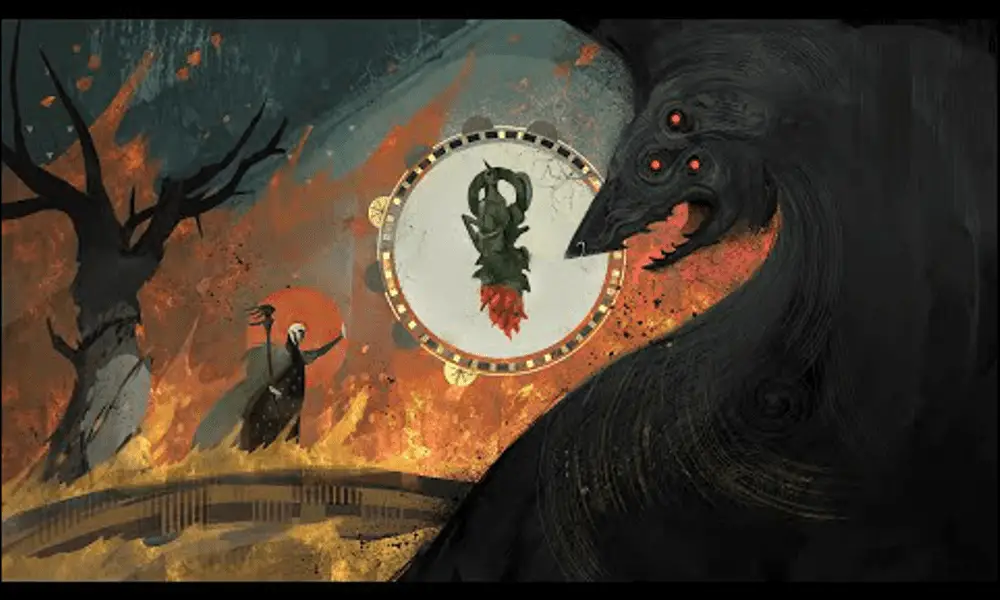
That second, full, wider image is absolutely crucial, not least for the tree that almost entirely disappears in the cropped version, so I’ll have a lot more to say about that farther down in the fresco analysis.
“When He Rises…” (Surprising Callbacks to Dragon Age II)
First off, as many fans already know, the image in the teaser is the red lyrium Idol discovered by Bartrand and Varric in the Deep Roads expedition in Dragon Age II. The focus on this idol is really fascinating. For one thing, it turns an item and event that wasn’t seen as terribly significant at the time (beyond the fact that it was the first appearance in the trilogy of what ultimately became known as red lyrium) into a highly significant event.
But the idol isn’t the first or even most important callback to Dragon Age II. First, there’s the matter of “The Dread Wolf Rises” as being an almost certain callback to Sandal’s Prophecy in Dragon Age II, when he says:
SANDAL:
One day the magic will come back. All of it.
Everyone will be just like they were.
The shadows will part and the skies will open wide.
When he rises, everyone will see.
Now, damned if that doesn’t sound like the events of Dragon Age: Inquisition, paired with Solas’s plans for the future as openly presented by him to us in “Trespasser.” Especially if the Veil indeed comes down and magic is as common as air.
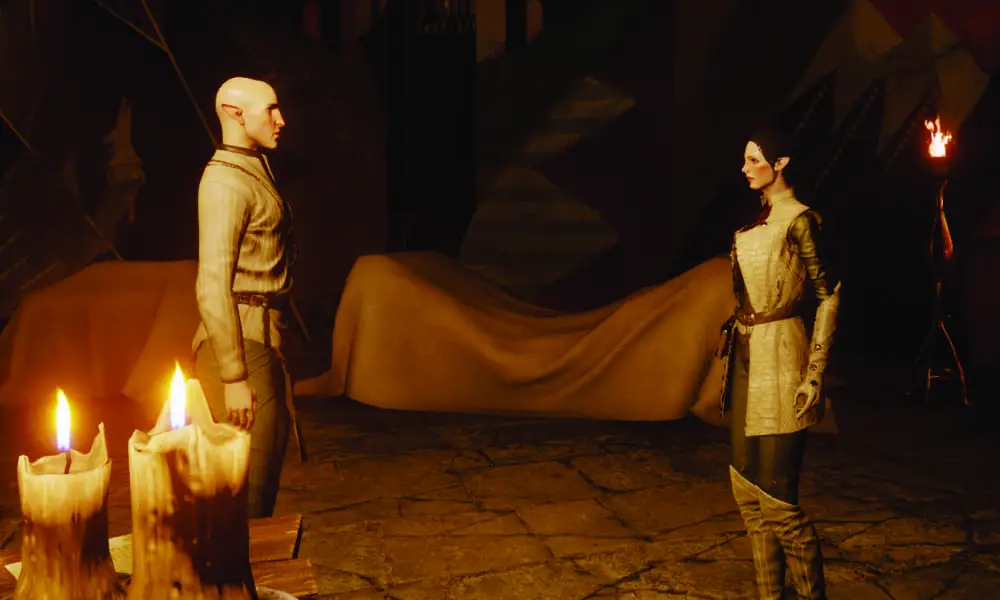
Magic “as Natural as Breathing”
When it comes to Solas’s goal, I’ve always been an outlier who believes that he absolutely won’t tear down the Veil, and that in fact Solas will end up saving it. Mainly because the Veil itself is in tatters and even if Solas does nothing, I believe it’s already doomed within the century.
But this trailer appears to prove me wrong… so if magic does become a part of the very air, what can we expect? Well, luckily, Solas has already provided some hidden clues, as he once described this very world to us in great detail at Haven in the following selected snippets:
SOLAS:
- Without [the Veil], imagine if spirits entered freely. The Fade was not a place one went, but a state of nature, like the wind.
A world where imagination defines reality, where spirits are as common as trees or grass. - Imagine if spirits were not — a rarity — but a part of our natural world… like a fast-flowing river. Yes, it can drown careless children, but it can also carry a merchant’s goods or grind a miller’s flour. That is what the world could be, if the Veil were not present. For better, or worse.
- Imagine ….. palaces floating among the clouds. Imagine beings who lived forever, for whom magic was as natural as breathing. That is what was lost.
This is important stuff, because it may very well be describing the environment (and alteration in powers and physics) caused if the Veil comes down. The Fade will become real, and dreams and visions will be a part of daily life. Spirits will be common companions and demons will be constant potential threats. Magic will be part of everyone and everything, and will even be able to negate gravity where desired.
Meanwhile, Sandal’s “everyone will be just like they were” seems to me to imply:
- The return of their lost immortality to the elves
- All elves will have inherent magical abilities (can you imagine Fenris or Sera reacting to this?)
- A return to balance for spirits and demons (no longer trapped in the Fade)
- That magic filling the air will return people to their core selves
- That Solas will use that magic to further restore the ancient glory days of the elven people as reflected in Arlathan
Let’s not forget the biggest consequence of all as admitted by Solas in “Trespasser” if the Veil comes down: The Evanuris (or “False Gods”) will be freed.
Whoops.
Now, Solas notes that he “had plans” for dealing with this in “Trespasser,” but still… that’s a huge thing for him to address so casually! And of course, what if the Veil doesn’t come down? I still have the feeling we’re gonna see an Evanuris or two get loose and wreak total havoc in rage and vengeance.
Life in a Veil-less World…
Meanwhile, what will happen to the different races if the Veil is, in fact, torn down?
My bet would be that all elves will find some degree of potential magic unleashed, while all latent mages will also manifest. I’d imagine there might also be a high number of horrifying and almost instantaneous Abominations, as well.
Meanwhile, we have no idea how humans will react biologically to such an environment, as humans have never existed, as far as recorded history tells us, in a world without the Veil.
My guess, based on the reactions of non-elves and humans to traveling through the Crossroads (thanks to Patrick Weekes‘s beautiful and evocative descriptions in The Masked Empire) is that humans facing a Veil-less world may find their perception of color slightly dimmed or weakened. They may feel slight vertigo and disorientation. The elves, will, conversely, feel stronger, more awake and alive, the magic tingling on their skin. They may actually see colors more intensely and experience emotions and sensations more acutely.
And that’s if he rises… and everyone sees.
The Figure in the Fresco
There’s been a ton of discussion on the central figure in the fresco, and whether or not it’s Solas, or whether it’s in fact some other member of the ancient tyrannical “false god” Evanuris (like, perhaps such bloody-minded gods as Elgar’nan or Falon’Din). However, I don’t think it’s either one of them, and that it is clearly Solas.
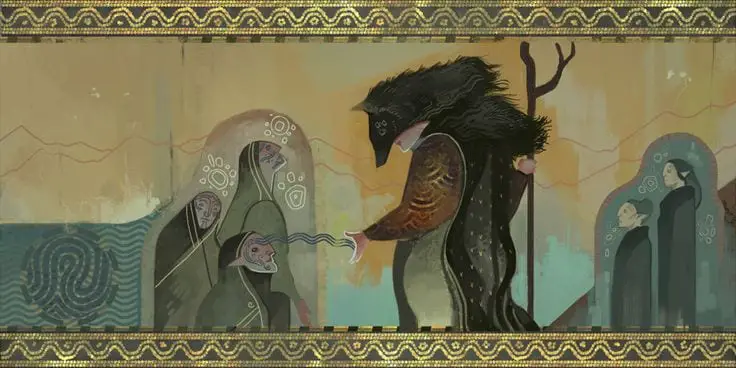
The reason I assume it’s Solas and not one of the other Evanuris is because of the repeated elements from past depictions of Solas in DAI and the “Trespasser” murals. Solas is frequently (commonly) depicted in both his man and Dread Wolf forms together in many of those past images, so to me this is simply more of the same. The images have always been heavily symbolic and metaphorical, and often seemed to demonstrate Solas’s state of mind, his inner self. For instance, on the romance Tarot, the ‘Dread Wolf’ is white, fuzzy, and adorable (and with two bright red eyes, but without the Pride Demon eyes the darker version carries). Then, in the infamous final “Tower” Tarot image for Solas, there he is, heading off into darkness with his branchy staff, the massive shadowy Dread Wolf (complete with Pride Demon eyes) looming over him, but also following obediently behind him.
This theme continues in “Trespasser,” where Solas is repeatedly shown alongside his Dread Wolf self almost in moments of joy and freedom, as in one of my favorites, where he appears to be leaning forward in flight, face uplifted, with the Dread Wolf running placidly behind him (although this could also be an image of Dread Wolf Solas helping former slaves take flight). Basically, we can see Solas’s mood or state of mind from looking at the wolf in the paintings. His current state of mind, from the Wolf we see in the new teaser, is potentially terrifying and tragic indeed.
In short, Solas appears alongside the Dread Wolf all over the place, from Inquisition to “Trespasser” to (I believe) this new mural. And while the baldness doesn’t necessarily mean it’s him (the Temple of Mythal shows us that all of the Evanuris were evidently bald), the canon branchy staff from his Tarot, the familiar repeated robe, the wolf-furred cloak, and the presence of the Dread Wolf are all familiar elements we’ve seen in his frescoes before. Even the stance, the quiet denial of the gesture, says “Solas” to me.
And I don’t think it’s Elgar’nan, because of the Solas-staff and cloak, but also because he was reported to wield light or fire. While yes, there is fire in the image, to me it is a representation of the burning of war or chaos—it doesn’t appear to be a weapon and stream of magic. And the figure with its upraised palm seems calmer, cooler, and is not emanating anything. I also don’t think it’s Falon’Din, because Falon-Din carried a shepherd’s-hook staff in his mosaic in the Temple of Mythal. And the cloak’s dark ruff of fur is somehow ‘wolfy’ to me, just as it was in the “removing the vallaslin” fresco I included above.
So yeah: I think it’s Solas, at the dark end of his lonely journey.
Secrets in the Teaser
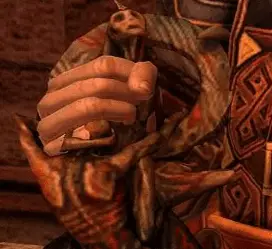
Plenty of people recognized the red lyrium idol shown in the teaser trailer, because it was a major plot point in Dragon Age II.
The initial gorgeous closeup of the idol is, however, wonderfully misleading and resembles, at first, the sun rising over a distant mountain range. This may be a subtle reminder of the Titans or a bigger-picture evocation that the story to come will affect all of Thedas.
When viewed in 3D, it’s more apparent than ever that the idol carving is a kind of ‘Pieta,’ an image of a woman in grief or torment cradling the ravaged body of what may or may not be a man (or son). Again: Mythal and Solas? (But who is the hidden third figure, way down on the lower right? I haven’t figured that out yet…) Meanwhile, it’s interesting and (I’m certain) deliberate that the first face we see is not the face of the female figure, but the hidden face, turned inward, of the male figure she embraces. Lines of red lyrium then slowly begin to appear and ‘crack’ the idol. Do they signify destruction, activation, or… awakening?
The idol was reportedly created by the dwarves of the Primeval Thaig long ago. After its fall, the idol was lost to history for thousands of years, until Bartrand discovered it on an altar inside a room of the Primeval Thaig in Dragon Age II. Already half-mad, Bartrand abandoned the party, then later went insane, saved a fragment of the idol, and sold the idol itself to Knight-Commander Meredith, who reshaped it to be her sword (which she named “Certainty”). Like Bartrand, Meredith too went mad, and was eventually defeated by Hawke and their companions.
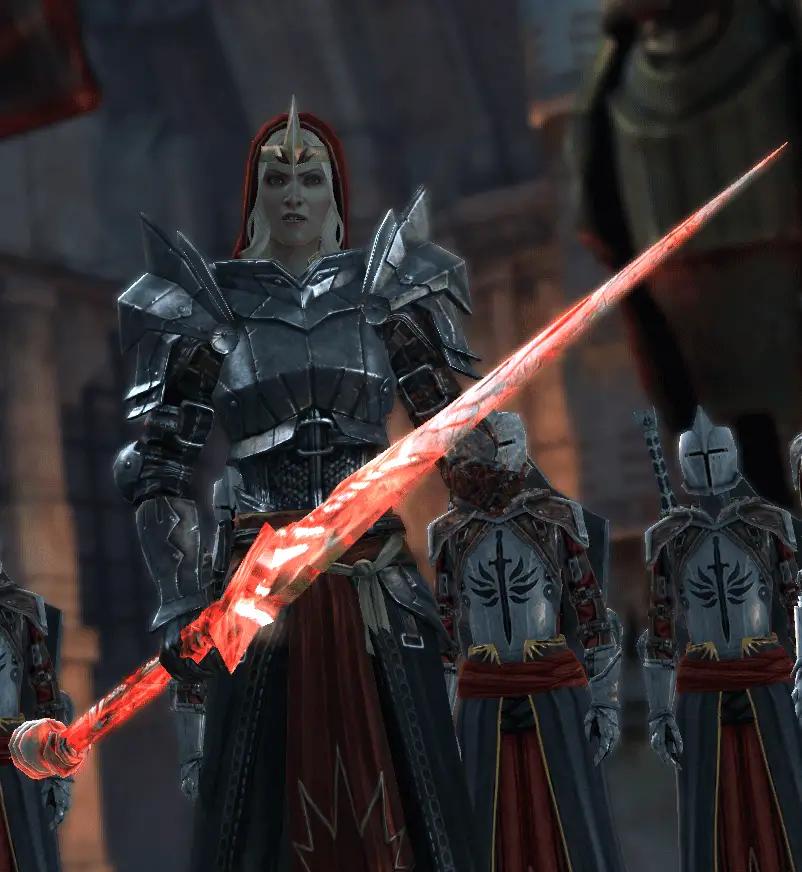
Now here’s where it gets interesting: During our final battle with Meredith, the idol (her sword) explodes into dust and she herself turns to solid lyrium.
So what is the idol we’re seeing in the trailer? The original is gone because, remember, in Dragon Age: Inquisition, on a Templar playthrough, Samson is wielding Meredith’s very sword, “Certainty.” Other conversations later tell us that the sword was reforged, using a dark combination of elven, Tevinter, and Blight magic.
But… either way, the idol doesn’t seem to exist anymore. So why is it featured here? Is it a vision of the past, or a harbinger of the future?
My take: It’s there because it’s when Everything Changed. We just didn’t know it yet. But, as with the Ring of Power in The Hobbit, this little idol signified the discovery of something Mythal had (I believe) tried to keep hidden and suppressed for millennia. The idol is the moment when red lyrium entered Dragon Age, stage left. And all Thedas may be doomed by it.
So let’s go back in time and explore how this is all coming together…
Theories from the Ancient Days
First off, I could be completely wrong. So, so wrong.
But. I believe that in the days before the Great War between the Evanuris and the Forgotten Ones, the Forgotten Ones may have attempted to defend themselves by hiding themselves (either Blight-infected on their own, or wielding some kind of Blighted potential weapon or bioweapon) in the nothingness of the Void. And that this place eventually ensnared and infected Andruil, who went hunting there, until she went too far… and (I believe) infected a titan. And then I think the following events occurred:
- Her mother Mythal intervened
- She mindwiped Andruil
- She removed Andruil’s ability to enter the Void again
- She killed the (infected?) Titan and buried it deep within the earth
- Until, I believe… it was found after many centuries, a wealth of toxic and irresistible red lyrium to be coveted and even possibly worshipped.
I also suspect that these events directly led to the murder of Mythal, and they’re also why she is whispered as being the source of the Calling (if we drink from the Well). Because the Calling, I believe, emanates from the infected Titan Mythal killed and buried so long ago. It may even have infected Mythal in some ways, or created some kind of mental link with her—let’s face it, red lyrium has been known to do that.
The Fresco Illustration as The Dread Wolf Rises
If the new fresco is a depiction of reality (and not a nightmare of Solas or the Inquisitor), then Solas has indeed likely torn down the Veil, because this sure as heck looks like the world “burning in raw chaos” to me. There are visible flames both in the fresco, and (in a neat and very dramatic effect) actual embers flying up before the fresco as well.
The idol is reportedly Andraste, but I’ve always wondered if it was someone else. Upon reflection, I now wonder if it is not in fact Mythal—holding, perhaps, Andruil, the daughter she had to defeat and punish? Or is it Mythal holding Solas, just as Solas once held Mythal in his own arms, grieving at what he had to do?
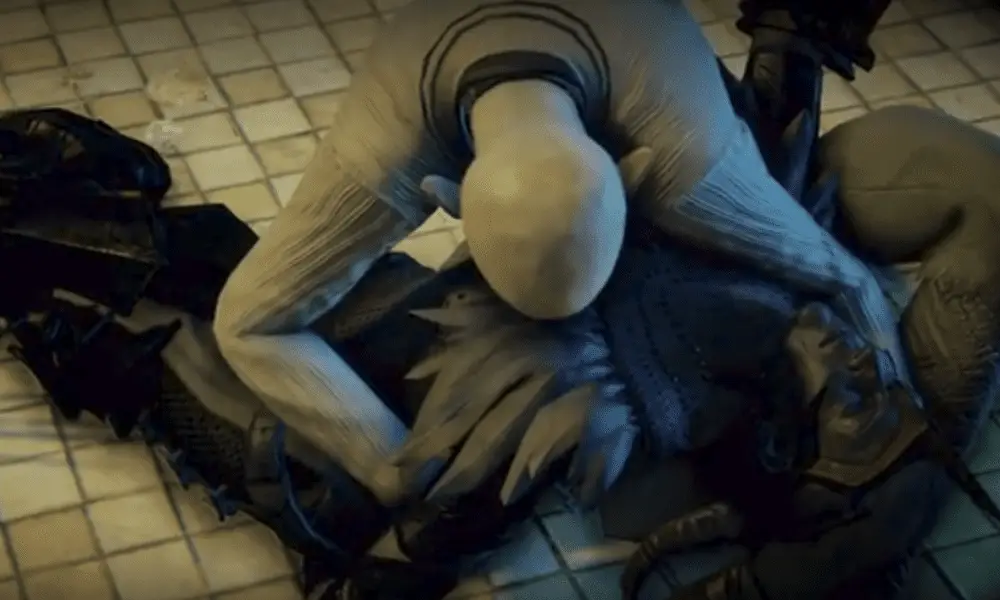
Another reason I think the idol is Mythal (or even possibly Andruil) is the serpent/dragon circle behind her. Remember that the dragon form was a ‘sacred’ form to the Evanuris. Complicating matters is the appearance of a third person on the idol, down on the lower-right side, partly hidden at almost all angles. I’m still pondering who I think that figure might be… the enslaved elves, underfoot?
The strong fresco motif of repeated circles (which seem to represent the Fade, as in Solas’s Tarot, and even in the Dread Wolf mosaic) is once again present, as are the representations of the elven orbs, with the main circle and active orbs brushed with gold leaf (in classical art, the use of gold leaf typically signifies the sacred or divine). Also, if you look closely at the Dread Wolf, it too is made up of swoops and circles and swooshes, especially around its red Pride Demon eyes (and this stylistic approach is something we’ve seen on Dread Wolf statues in and around the Temple of Mythal in-game). And there is that deep red halo around Solas. Signifying corruption and simple red lyrium exposure? Or, more complexly, the Fade? Divinity? Power? Even on his first Tarot card, Solas there, too, wears a kind of halo.
There are seven orbs studding the central circle around the red lyrium idol, corresponding to the seven Evanuris imprisoned by Solas as well as possibly to the seven Old Gods of Tevinter (mirrored in the seven archdemons). Here, all but two orbs are now “dark” and lifeless. I’m assuming this is because of the deaths of the five archdemons. I wonder if killing an archdemon actually freed the corresponding Evanuris—if they are linked—from its metaphysical prison, versus killing it.
The little downward triangles we’ve seen on other frescoes are repeated here. Some have noted that these may be an evocation of the Fade, of the female (Mythal, Flemeth, Morrigan, the romanced Inquisitor, or Andruil), but I almost wonder if they’re simply a powerful representation of “the sky is falling.” That these are the end times.
Other Symbols and Metaphors
The figure I believe to be Solas is standing on an arched road, or what I believe to be a bridge. A burning bridge, to be exact (gotta love those sneaky metaphors), whose flames are burnished with bright gold, echoing the borders of the idol circle.
Not only do we see the full tree behind him, but it is visibly burned, and there is something winding up the center of the trunk in a diagonal fashion. This makes me fairly certain the tree is a vhenadahl, one of the trees sacred to Elves, and which is frequently painted or decorated to celebrate the elves.
According to this Codex entry from Dragon Age: Origins, the vhenadahl was also a symbol of Arlathan, a fact increasingly forgotten by modern elves. For extra gravitas, it’s worth noting that “Burn the Vhenadahl” is an actual quest in the Dragon Age:Origins DLC, “The Darkspawn Chronicles.” And now here we are looking at an actual burned vhenadahl. Is it a representation of destroyed Arlathan? Is it a representation of something more recent? Did the tree burn in the “raw chaos” of the destruction of the Veil (which we may be seeing now)?
Last but not least, the tree may also reference the vallasdahlen, or “life-trees,” the trees planted by the Dalish to honor and remember those who die as part of the funeral ritual (and possibly as a protective act against demons). And then again, I also believe the tree may also subtly reference Andruil and the Vir Tanadhal, or “Way of Three Trees.” (I’m telling you, Andruil is gonna have a big part to play in DA4. I’m convinced. Subtly, she’s everywhere we look.)
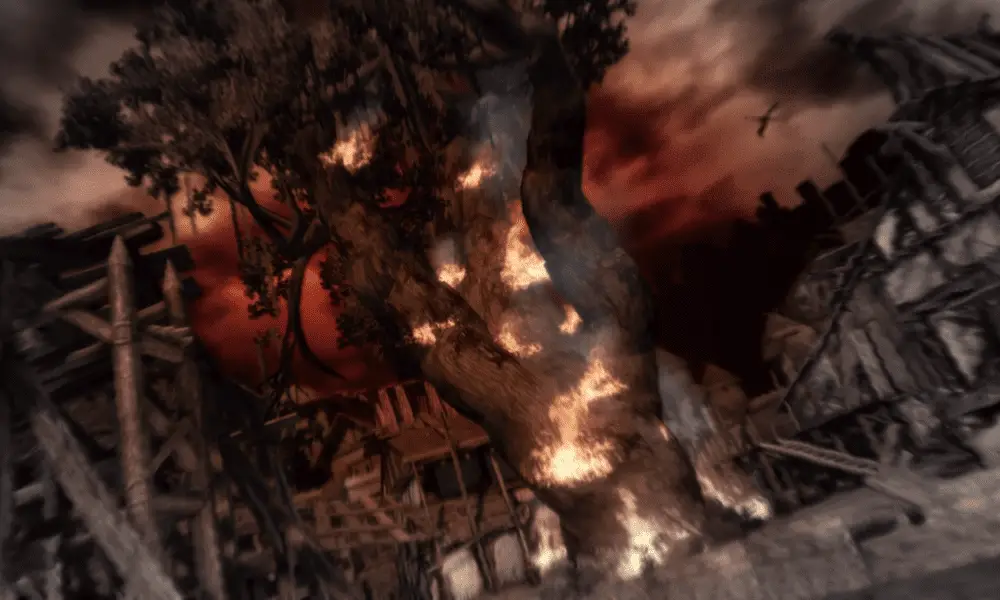
Where Willows Wail
Speaking of lore, the ancient elven poem “Where Willows Wail” has some very intriguing elements, and one very important tree reference. Please note that I have taken the liberty of smoothing out some of the translation here and that it is of course subjective in nature. It’s fun to note that the opening stanza is in iambic tetrameter (or, in a series with four “feet,” or unstressed/stressed syllables in a row). It made me wonder if Patrick Weekes (who wrote Solas, Bull, and the alliterative, poetic Cole for Inquisition) wrote this.
To me, this poem is directly referenced in the new teaser elements:
When waked, we walked where willows wail,
Whose withered windings want wassail.
We weary-worn with wited wale,
Were wavering with wanion ward.
When wishing waned, we wighters warred.
When wolfen wan, we wastrels warred.
We lost eternity and the ruined tree of the People
Time won’t help when the land of dreams is no longer our journey
We try to lead despite the eventual failing of our markings.
To the inevitable and troubling freedom we are committed.
When we could no longer believe, we lost glory to war.
When the Wolf won, we lost the People to war.
This feels intensely relevant—I love all the hidden references to waking and dreaming—obviously, I believe, references to the Fade and to uthenera. I think most of the poem may actually be spoken from the point of view of one of the ancient elven sentinels, like Abelas, both mourning the past and their own weakness (the “eventual failing of our markings”). The loss of eternity and tree is of course the loss of immortality, and the loss of the People in general (and Arlathan). It’s interesting that they, like Solas, view their commitment to freedom as both necessary and troubling. And of course, in the end, they lost it all.
Solas, it might be argued, is the last sentinel elf. And the most vigilant and determined.
And now “the land of dreams is no longer [his] journey,” which also echoes his final conversation with a romanced Inquisitor, when he tells her he now walks the path of death, the din’anshiral, and he would not have her see what he becomes. I feel like this mural’s very title could be “The Din’anshiral.”
Figure Details
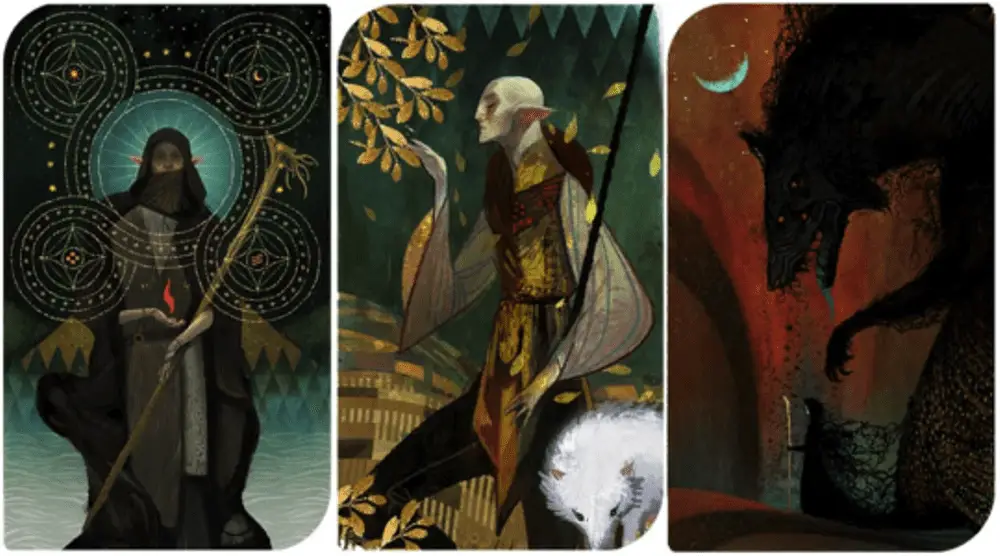
As I noted above, Solas appears to be carrying the same “branchy” staff he carries in his original Dragon Age: Inquisition Tarot card. Most notably, however, the staff is now black (has it been ‘burned’ in the raw chaos?). Or is it simply darker after the events of DAI? The staff we see in the mural in “Trespasser,” for instance, is also noticeably darker.
And beyond the fact that Solas appears to be wearing a variation on the robe he wore in the “Removing the Vallaslins” fresco from “Trespasser,” look closely at the pattern: It’s a series of crucifixes. Solas is already a subtly sacrificial figure even in his original Tarot, and let’s face it, nobody wears regret as eloquently, as beautifully, or as openly, as Solas. Speaking of Solas’s wardrobe, he’s also “wolfier” here than we have ever seen him, and for the first time he is wearing a full-on furred cloak.
Another key detail is that Solas’s eyes are red here, and I believe it’s the first time we’ve seen them this way. To me this is incredibly important, because I believe the red eyes in the frescos and Tarot cards signify connection to the Fade (they may also signify some kind of corruption but I’ll address that another time). Please note that Solas’s white wolf in the “romanced” Tarot also has red eyes, as of course does the Dread Wolf with the red Pride Demon eyes (as does SERA in her “romanced” Tarot). Are Solas’s eyes red because of the removal of the Veil? Or because he has now been corrupted by red lyrium? If it’s red lyrium, it may be worth heading back over to revisit “In Hushed Whispers” again with a tainted Solas…
Solas is also holding up his left hand, which is interesting as it carries echoes of the Inquisitor and the Mark, as well as the stance used in closing a rift. He stands thus as if in denial. It is not an antagonistic pose, exactly, but resolute and almost sorrowful.
The Dread Wolf here is rampant and on the attack, complete with lolling tongue and upraised head. Keep in mind that even in his final Tarot (“The Tower”), Solas’s Dread Wolf appears brooding but obedient, overshadowing but following him. Yet here it is confronting him, absolutely. They are divided, perhaps forever.
Is this a literal representation or a sign that Solas will be at war within himself? If it’s literal, my guess is that what we’re seeing is Solas fighting his own monster-self in the Fade (I’ve written on this elsewhere, but I believe Solas’s Dread Wolf is an actual aspect of Solas that he is capable of wearing within the Fade).
The Hidden Country
Meanwhile, let’s look at the mural again, and pull back slightly for the big picture.
The skies could be argued as being twilight, or a greenish, misty dark blue. Below those skies, high above Solas and the tree at left, we see the jagged shadowy shapes of what might be mountains (or the jagged walls of the physical Fade). I’m voting that it’s mountains because of the little visual trick at the beginning of the teaser in which the edges of the idol look like mountains as the sun rises over the Frostbacks. I also think these are mountains here because of Solas’s secret towers and hideouts in “Trespasser,” at least one of which appeared to be hidden in the Vimmarks. I also think, slightly lower, that we see two kinds of flames in the image: actual flames (again, perhaps the burning of the “raw chaos”), and then, much higher than Solas, the flame-colored essence of the Fade.
Between Solas and the sky, however, echoing the general flow of the tree branches, notice something else? There’s a structure there, almost like the gabled roof of a building or temple—a straight and diagonal line, clearly edged and shadowed, that appears to come to a point offscreen above the central circle image of the Lyrium Idol. To me, it almost looks like the Cornice of a Greek temple.
What is this structure? Is it somewhere we’ve been before? Is it the Black/Golden City? Arlathan? Skyhold?
Also, note the striped patterns on the bridge beneath Solas, and look at the romanced Tarot I’ve posted here farther up: Those same exact patterns appear on the earth behind Solas’s feet.
Solas is standing in the middle of a burning bridge. Behind him is the burned and destroyed symbol of Arlathan. Before him is the face he never wanted anyone to see—the savage dark face he wore “as a symbol of Pride,” given by his enemies, those who enslaved their own people and marked them like animals. And between them both is an image of grief, loss, and agony, of Blight and corruption, encircled by the divine reminder that once he was part of a group of nine, and that seven of the eight who remained are sundered forever from him.
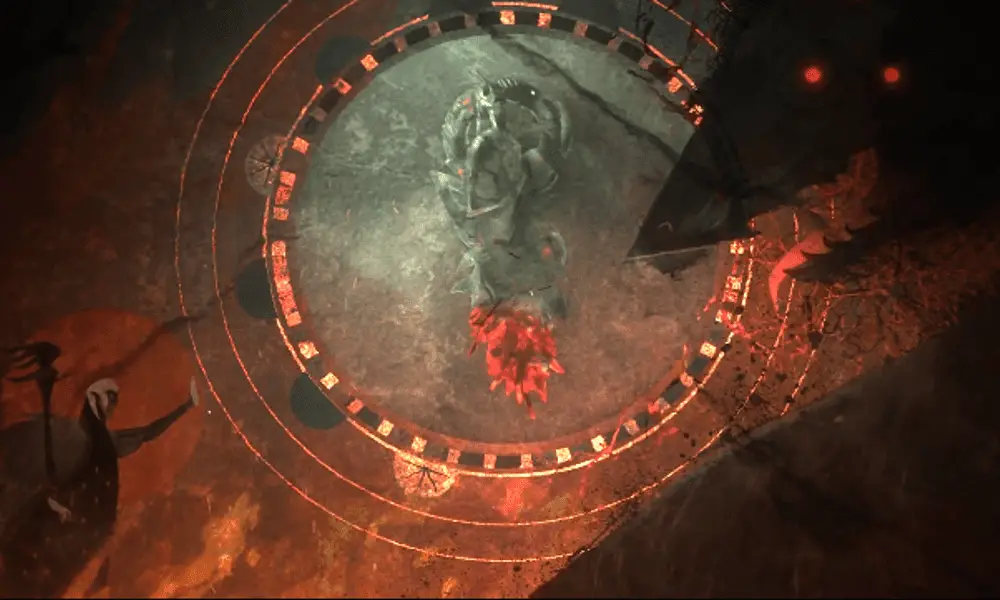
Subtle Differentiations and Lines of Power
As the video of the idol transforms to the fresco, some really interesting and subtle things begin to happen. The ending fresco image is not the same one we see in the flat fresco.
Look at the screen shot I’ve taken above from the teaser. The central idol remains the “real” one, not the painted version. And there are subtle, smoky lines of power, Blight or corruption emanating from Solas, his staff, and from the Dread Wolf.
The Dread Wolf, meanwhile, is markedly different from the flat fresco version—no circles or swirls, and it has subtle shimmering, transparent, smoky like lines of power. We can actually see some of those lines through the wolf’s face (it’s much more transparent here than in the original fresco, which only has slight elements). Is this yet another clue that the Wolf is emblightened, exuding the Blight as the Archdemons once did?
Several smart people on Twitter have been positing that this Wolf is not THE Wolf, and that, in fact, the representations of the Dread Wolf on frescoes across the games has actually been a misdirection in which we are seeing different wolves, perhaps Solas’s “pack” of followers, even some of the Forgotten Ones. I think this a pretty amazing idea, and I absolutely agree that this could be the case.
But the thing that trips me up, as here, is the consistent presentation of the Pride Demon Eyes in all the Dread Wolves we’ve seen, save for the fluffy, almost coy White Wolf on Solas’s Hierophant/Fool romanced Tarot card. For me this heralds the Wolves (and this one), on an intimate and personal level, as representations of Solas (“Pride”) himself.
Meanwhile, there’s something else interesting about both presentations of the Wolf here: It appears to be the only source of the red lyrium energy in the image. If we look closely, there are almost electric arcs and crackles of red energy around the Dread Wolf’s head, extending up above the Idol Circle and especially all around the Dread Wolf’s head and mouth. And yet there are no cracks of red upon the Dread Wolf himself. Just that lolling red tongue, which was a distinctive greenish-blue in the Tower Tarot previously. Is he the source of the Red Lyrium or corruption? Or is this simply another representation of Fade energy?
So it appears that the Wolf exudes two things at once: darkness (Blight?) and redness (corruption, lyrium, the Fade). Also, note the fact that in the flat artistic rendition of the fresco, just above the wolf’s head and down into the area behind his jaw, we can see a fine network of cracks in the fresco, the only place they occur this deeply (except possibly also below the Wolf’s jaw as well). Those cracks are notably missing from the final teaser video image.
Either way, all things considered, whether it was tame before, the Wolf now appears to be pretty clearly an element of chaos, corruption, and destruction.
And is that now what Solas himself has become? The destroyer of all worlds? Or… their savior?
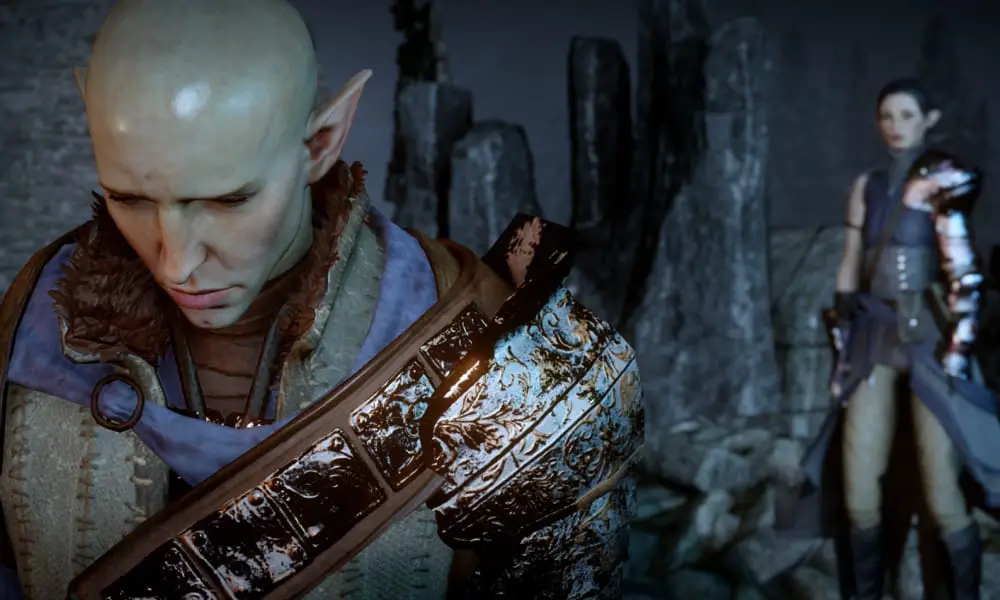
The Dread Wolf Speaks
And then the real idol becomes the fresco, the sparks fly up, and we hear that unmistakable voice, in all its beauty, thanks to Gareth David-Lloyd.
SOLAS: So. You’ve found me at last. I suspect you have questions.
But something’s wrong. Solas isn’t just sad or weary when he speaks those final words. He is in physical distress, possibly agony. If you listen very closely to the teaser, just as the music crescendoes then falls, you can actually hear Solas gasping for breath behind the music. It’s very subtle but it’s there. It culminates in a great indrawn gasping breath just before he says, “So.”
As others have already noted, it doesn’t end there. Solas’s voice is ever so slightly warped, lower, slower. Still beautiful (of course) but perhaps corrupted? Is it red lyrium after all? Or simple exhaustion and despair at last, after so much life, hubris, and struggle?
This is not the cool, confident, and amused voice of the ascendant elven god we met in “Trespasser.” This is the ragged, exhausted voice of a Solas who has reached the end of his road into hell, his dinan’shiral. This is the voice of a Solas who wants to die. Who certainly sounds as though he is reaping the pain and despair he foresaw for himself at the end of “Trespasser.”
I freely admit my Solas biases, but I still do not think this is the voice of an actual villain or antagonist. I still stand by my theory that I don’t think Solas will be our main focus in Dragon Age 4. I think rather that when Solas tears down the Veil (if in fact he does so) that both Tevinter and the Qunari will swoop in, eager for the chance to use this vulnerable moment to achieve world conquest even while the world burns (and we all know what Alistair says about swooping!). At that point, I suspect that a Thedas torn once again by war and potential conquest will look around, realize they left the elves out of the equation, and note that they are, as assembled by Solas, now a world power in their own right, especially as led by a guy who can turn armies to stone at a glance.
At that point, Ferelden and Orlais especially may just rethink their options. Maybe giving elves their due—at long last—wouldn’t be such a bad idea.
After all, the fate of all Thedas may hang in the balance.
And I still have questions. So, so many questions. How about you?
Images Courtesy of BioWare
This article is a reprint (with minor modification and expansion) of a two-part article originally published by Angela D. Mitchell on DumpedDrunkandDalish.com.

